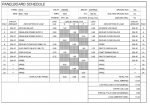i.qasim
Member
- Location
- Saudi Arabia
Dear Engineers,
I have to panel board schedules in front of me, both designed by well known engineering firms.
as shown in images.
my question is.. which on is correct... OR where am I stumbling...
[in one schedule, they have calculated total load by taking average of the single phase loads on each phase. in other, they have added the single phase loads on each phase :/ ]


Lets say I have 18 lights of single phase load 10W each.
I divide it 6 lights per phase in a panel board,
what is the load on this panel board:
60W? as each phase has 60W load.
or 180W?
and what load will I use in the formula to find current for CB and cable selection
"P=uder_the_root 3*V*I*power_factor"
thank you very much.
I have to panel board schedules in front of me, both designed by well known engineering firms.
as shown in images.
my question is.. which on is correct... OR where am I stumbling...
[in one schedule, they have calculated total load by taking average of the single phase loads on each phase. in other, they have added the single phase loads on each phase :/ ]


Lets say I have 18 lights of single phase load 10W each.
I divide it 6 lights per phase in a panel board,
what is the load on this panel board:
60W? as each phase has 60W load.
or 180W?
and what load will I use in the formula to find current for CB and cable selection
"P=uder_the_root 3*V*I*power_factor"
thank you very much.
Last edited:
